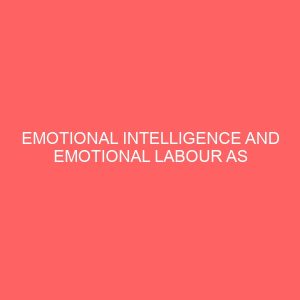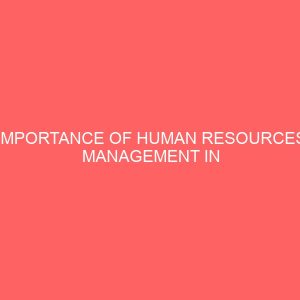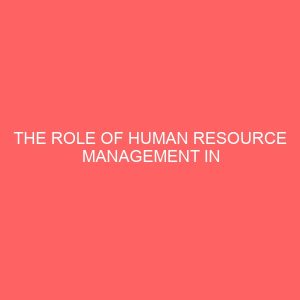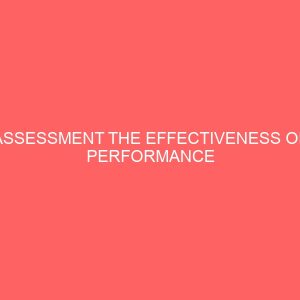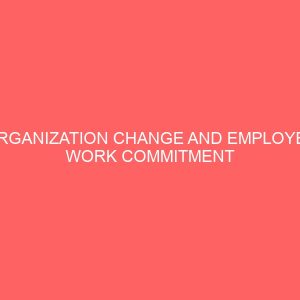Description
CHAPTER ONE
INTRODUCTION
1.1 Background of the study
The Workplace is an environment for upgrading, improving and reforming the traits related to emotional intelligence competencies such as perception and control of emotions.
Emotional intelligence is an important forecaster of key organizational outcomes including job satisfaction, organizational commitment among civil servants. A person who is able to understand and isaware of one’s own feelings, and controls stress, negative emotions, and feelingof frustration, can certainly have better relationships with colleagues and supervisors, which ends in increasing job satisfaction, organizational commitment and better jobperformance (Bernard).
Emotional intelligenceexplains the ability to perceive, control and evaluate emotions.In 1990, researchers defined emotional intelligence as the subset of social intelligence which involves the ability to monitor one’s own and others’ feelings and emotions, to discriminate among them and to use this information to guide one’s thinking and actions. It is believed that emotional intelligence can be learned and strengthened, while others believe it is an inborn trait.Some emotional and social competencies are important in the workplace,which include adjustment in the face of the problems, self-management, interpersonal effectiveness, discussionskills in the face of different opinions and disagreement. Emotional intelligence improves the performance of theorganizations, and has an important role in productivity and effectiveness of the organizations; therefore, employeeswith high emotional intelligence are considered invaluable assets (Yagazie: 2000).
Public service by nature is a service-oriented organization. Governmentalactivities are allotted to the ministries who in turn are expected to deliver services to thepublic. Thus, as service providers, the ministries are always in constant touch with themembers of the public. This interaction goes a long way in the public perception andassessment of government performance. No matter how unpleasant their job is, publicservants have to keep their feelings under control in order to safeguard, the interest oftheir employer. It is at this point that emotional labour comes in. Emotional labor is a requirement of a job that employees display required emotions toward customers or others. More specifically, emotional labor comes into play during communication between worker and citizen and between worker and worker (Wikipedia).Emotional labour holdsthat employees should display emotions that comply with certain expression norms orrules of the organization which help to create desired state of mind in the customer. Bythis, employees are expected to appear happy, nice and glad when rendering service totheir customers regardless of any private misgivings or any different feelings they mayhave.
Organizational commitment is considered an important forecaster for somepositive and negative outcome variables. Employees with strong affective commitment to the organization perform better than those with lower levels ofaffective commitment. It is positively related with employees’ motivation, job performance, and job satisfaction, andnegatively related with absenteeism and turnover, as well as stress. Uncommittedemployees not only had the lowest level of acceptance of organizational values, but they also felt alienated from theorganization. (Scarborough and Somers, 2006) Salovey and Mayer (1990, p. 189) define emotional intelligence as“the ability to monitor one’s own and others’ feelings, to discriminate among them, and to use this information toguide one’s thinking and action.” Human resources who have the ability to communicate with each other effectivelycan lead the organization toward success and effectiveness. Therefore, individuals recruited in the organizationsshould be aware of and understand emotions in the self while knowing that they are, what they believe in, whatthey say, what they think, how they make decisions, how not to get angry, how to control one’s emotions in differentconditions, and how to act with others. In such a situation, they will be able to recognize and control emotions in others.
1.2 Statement of the problem
Employees with high emotionalintelligence confront low occupational stress in their job environment, yet employees with low emotionalintelligence have less self-awareness, and as a result, in the face of difficult conditions, they are not able to copewith their feelings and have too much stress which, in turn, has a negative influence on their job satisfaction and commitment.
1.3 Objectives of the study
The main objective of this study is to examine emotional intelligence and emotional labour as determiinant of organizational commitment among public servants.
2. Toinvestigate the effect of emotional intelligence and emotional labour.
3. To look at the predictability of emotional labourfrom the combination of emotional intelligence, self-efficacy and organizational commitment.
1.4 Research questions
1. In spite of economic, hierarchical, and management problems in an organizations, especially in the public organizations, can emotional intelligence be a solution for increasingjob satisfaction and organizational commitment and diminishing occupational stress in the workplace?
2. Are thereother factors and variables having mediatory roles in the effects of emotional intelligence on organizationaloutcomes such as organizational commitment?
3. What is the pattern of relationship among emotional intelligence, self-efficacy,pay satisfaction and emotional labour?
4. What is the overall effects of emotional intelligence, self-efficacy and paysatisfaction on emotional labour?
1.5 Research hypotheses
Ho:there is no significant negative relationship between emotional intelligence and emotional labour.
Hi: there is significant negative relationship between emotional intelligence and emotional labour.
Ho: Employees with strong affective commitment to the organization do not perform better than those with lower levels of affective commitment.
Hi:Employees with strong affective commitment to the organizationperform better than those with lower levels of affective commitment.
1.5 Significance of the study
1. This study will help and teach individuals recruited in the organizations to be aware of and understand emotions in the self while knowing that they are what they believe in, what they say, what they think, how they make decisions, how not to get angry, how to control one’s emotions in different conditions, and how to act with others.
2. The study will teach staff, individuals how to able to recognize and control emotions in others.
1.7 Scope/Limitations of the study
This study on emotional intelligence and emotional labour as determinant of organizational commitment among public servants.

